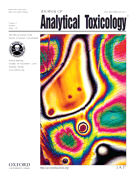-
PDF
- Split View
-
Views
-
Cite
Cite
David E. Moody, Medical Toxicology of Drug Abuse: Synthesized Chemicals and Psychoactive Plants, Journal of Analytical Toxicology, Volume 37, Issue 1, January/February 2013, Page 50, https://doi.org/10.1093/jat/bks088
Close - Share Icon Share
Medical Toxicology of Drug Abuse is the second in a series of four books concerning medical toxicology. The first, on natural substances, was published in 2008, the third and fourth will cover occupational and environmental exposures and pharmaceutical overdose. The division into four books offers a tradeoff: each chapter that represents a separate drug or xenobiotic is very complete, but some subjects get divided into separate tomes. For example, this book on drug abuse covers some of the opioids such as heroin, methadone and fentanyls, whereas others such as morphine and oxycodone will appear later in the pharmaceutical overdose book. These are very complete works, and one would hope to have a set no further away than the closest library. If the expense is not a deterrent, then a set within each laboratory would be preferable.
Medical Toxicology of Drug Abuse covers an expanse of topics. The primary sections (with the number of chapters in parentheses) are: amphetamine and phenylethylamine derivitives (4), club drugs (7), eating disorders and appetite suppressants (3), ergogenic agents and supplements (6), ethanol (1), lysergic acid diethylamide (1), other sedative hypnotic drugs (5), opioids (6), phencyclidine (1), volatile substance abuse (this includes one chapter on the primary topic, five on anesthetics, one on fluorinated alkanes, nine on industrial hydrocarbons and one on amyl and butyl nitrates) and psychoactive plants (15). This is not a small selection of abused substances.
Most of the chapters in each book are authored by Donald Barceloux. Six of the 66 chapters in the drug abuse book are written by other contributors. It is reported that Dr. Barceloux wrote 171 of the 185 chapters of the first book. This must explain, in part, why the four books are released over a period of time. Just one book is a huge accomplishment. The book also includes a list of reviewers, many of whom are well known to the readers of this journal. Many others are acknowledged for their contributions. Their assistance points to the magnitude of knowledge included in this tome.
Each chapter follows a standard format, which includes sections on the following: history, botanical description (for plant materials), identifying characteristics, exposure, dose effect, toxicokinetics, histopathology and pathophysiology, clinical response, diagnostic testing and treatment. Along with a thorough index, it is easy to locate specific topics.
When one reads a full chapter, the thoroughness of the subject matter is evident. For the scholar in any one area, however, it is possible to find a few subjects that are lacking. As an example, few drug interactions with buprenorphine are mentioned, which neglects work published since 2006 on buprenorphine and anti-retroviral agents by my colleagues Dr. McCance-Katz and Dr. Bruce. With such a massive amount of literature to cover, it is not surprising that some of the more recent findings are not included. The book does strive to stay up-to-date: the cathinones and synthetic cannabinoids are included. It is the nature of textbooks that they cannot catch all of the last-minute findings. Medical Toxicology of Drug Abuse includes so much that one must congratulate the accomplishment.




